2017 DODGE GRAND CARAVAN warning light
[x] Cancel search: warning lightPage 26 of 530
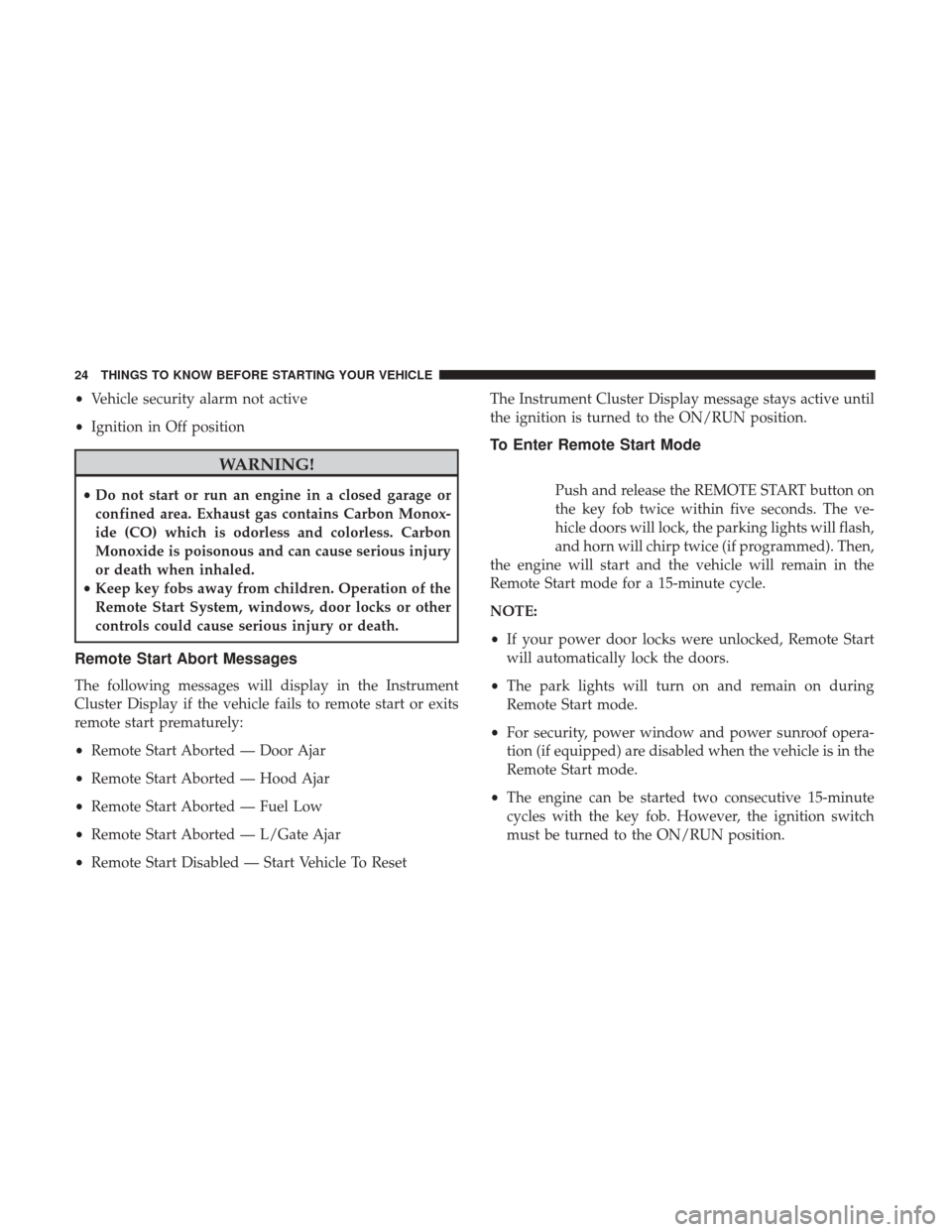
•Vehicle security alarm not active
• Ignition in Off position
WARNING!
•Do not start or run an engine in a closed garage or
confined area. Exhaust gas contains Carbon Monox-
ide (CO) which is odorless and colorless. Carbon
Monoxide is poisonous and can cause serious injury
or death when inhaled.
• Keep key fobs away from children. Operation of the
Remote Start System, windows, door locks or other
controls could cause serious injury or death.
Remote Start Abort Messages
The following messages will display in the Instrument
Cluster Display if the vehicle fails to remote start or exits
remote start prematurely:
• Remote Start Aborted — Door Ajar
• Remote Start Aborted — Hood Ajar
• Remote Start Aborted — Fuel Low
• Remote Start Aborted — L/Gate Ajar
• Remote Start Disabled — Start Vehicle To Reset The Instrument Cluster Display message stays active until
the ignition is turned to the ON/RUN position.
To Enter Remote Start Mode
Push and release the REMOTE START button on
the key fob twice within five seconds. The ve-
hicle doors will lock, the parking lights will flash,
and horn will chirp twice (if programmed). Then,
the engine will start and the vehicle will remain in the
Remote Start mode for a 15-minute cycle.
NOTE:
• If your power door locks were unlocked, Remote Start
will automatically lock the doors.
• The park lights will turn on and remain on during
Remote Start mode.
• For security, power window and power sunroof opera-
tion (if equipped) are disabled when the vehicle is in the
Remote Start mode.
• The engine can be started two consecutive 15-minute
cycles with the key fob. However, the ignition switch
must be turned to the ON/RUN position.
24 THINGS TO KNOW BEFORE STARTING YOUR VEHICLE
Page 27 of 530
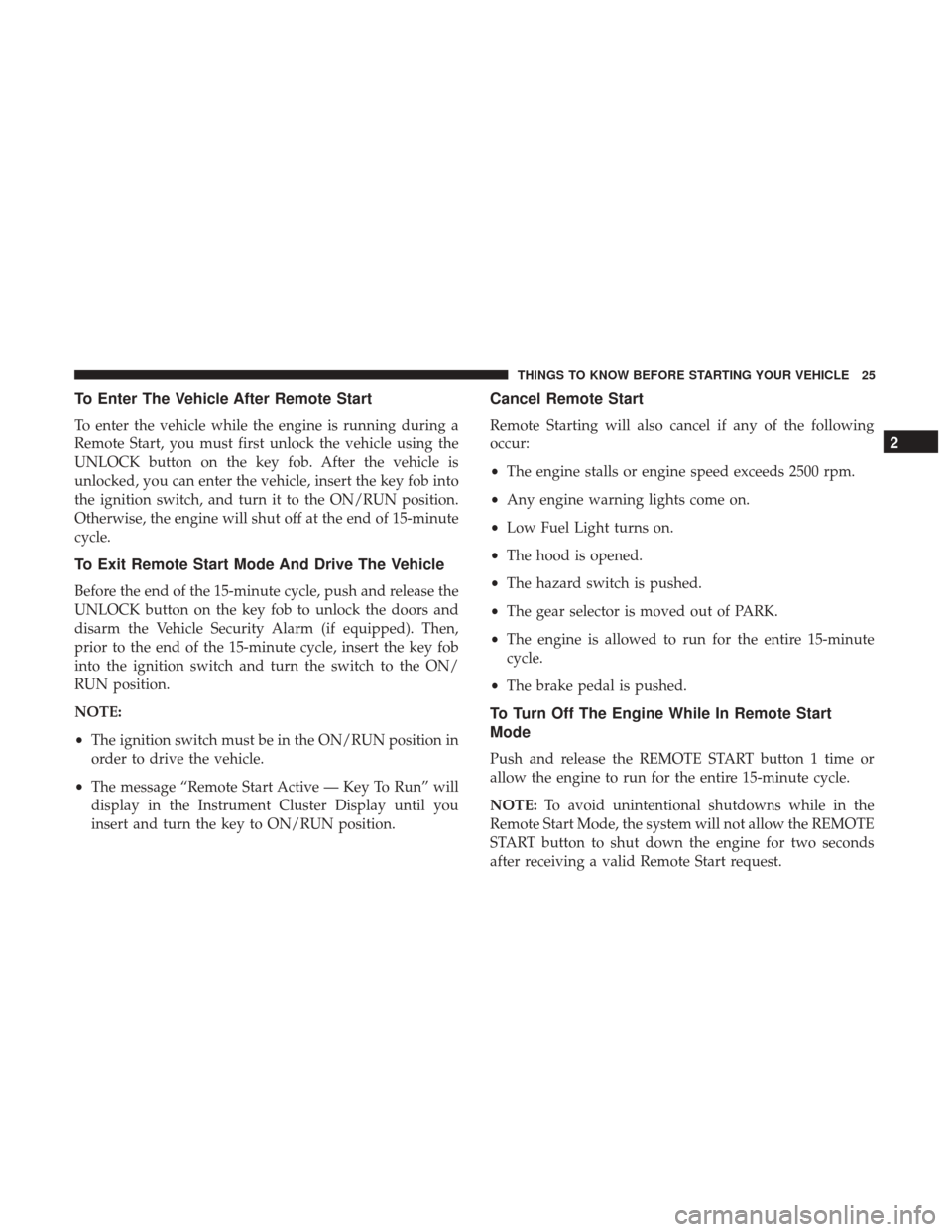
To Enter The Vehicle After Remote Start
To enter the vehicle while the engine is running during a
Remote Start, you must first unlock the vehicle using the
UNLOCK button on the key fob. After the vehicle is
unlocked, you can enter the vehicle, insert the key fob into
the ignition switch, and turn it to the ON/RUN position.
Otherwise, the engine will shut off at the end of 15-minute
cycle.
To Exit Remote Start Mode And Drive The Vehicle
Before the end of the 15-minute cycle, push and release the
UNLOCK button on the key fob to unlock the doors and
disarm the Vehicle Security Alarm (if equipped). Then,
prior to the end of the 15-minute cycle, insert the key fob
into the ignition switch and turn the switch to the ON/
RUN position.
NOTE:
•The ignition switch must be in the ON/RUN position in
order to drive the vehicle.
• The message “Remote Start Active — Key To Run” will
display in the Instrument Cluster Display until you
insert and turn the key to ON/RUN position.
Cancel Remote Start
Remote Starting will also cancel if any of the following
occur:
•The engine stalls or engine speed exceeds 2500 rpm.
• Any engine warning lights come on.
• Low Fuel Light turns on.
• The hood is opened.
• The hazard switch is pushed.
• The gear selector is moved out of PARK.
• The engine is allowed to run for the entire 15-minute
cycle.
• The brake pedal is pushed.
To Turn Off The Engine While In Remote Start
Mode
Push and release the REMOTE START button 1 time or
allow the engine to run for the entire 15-minute cycle.
NOTE: To avoid unintentional shutdowns while in the
Remote Start Mode, the system will not allow the REMOTE
START button to shut down the engine for two seconds
after receiving a valid Remote Start request.
2
THINGS TO KNOW BEFORE STARTING YOUR VEHICLE 25
Page 34 of 530

NOTE:If the window runs into any obstacle during “Auto
Up,” it will reverse direction and then go back down.
Remove the obstacle and use the window switch again to
close the window. Any impact due to rough road condi-
tions may trigger the auto reverse function unexpectedly
during “Auto-Up.” If this happens, pull the window
switch lightly to the first detent and hold it to close the
window manually.
WARNING!
There is no anti-pinch protection when the window is
almost closed. Be sure to clear all objects from the
window before closing.
Auto Up Reset — If Equipped
Should the “Auto Up” feature stop working, the window
probably needs to be reset. To reset “Auto Up”:
1. Pull the window
switch up to close the window
completely and continue to hold the window switch
up for an additional two seconds after the window is
closed.
2. Push the windowswitch down firmly to the sec-
ond detent to open the window completely and
continue to hold the window switch down for an
additional two seconds after the window is fully
open.
Sliding Side Door Power Window Switch — If
Equipped
Second row passengers may open and close the sliding
door window by a single window switch on the door
handle assembly.
The window switches will operate only when the ignition
switch is in the ON/RUN or ACC position and during
power accessory delay.
NOTE: The window switches will not operate if the driver
has activated the Power Window Lockout.
32 THINGS TO KNOW BEFORE STARTING YOUR VEHICLE
Page 37 of 530
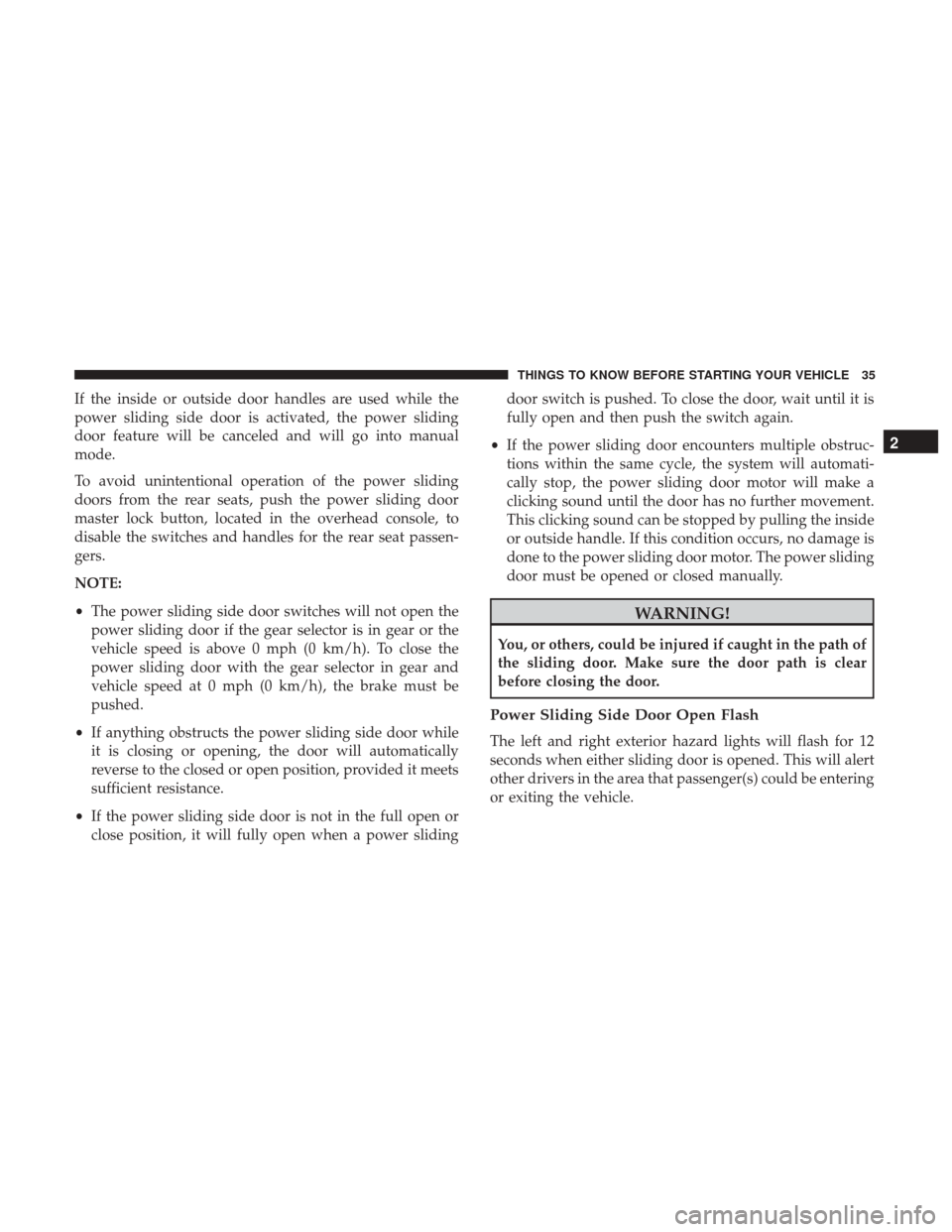
If the inside or outside door handles are used while the
power sliding side door is activated, the power sliding
door feature will be canceled and will go into manual
mode.
To avoid unintentional operation of the power sliding
doors from the rear seats, push the power sliding door
master lock button, located in the overhead console, to
disable the switches and handles for the rear seat passen-
gers.
NOTE:
•The power sliding side door switches will not open the
power sliding door if the gear selector is in gear or the
vehicle speed is above 0 mph (0 km/h). To close the
power sliding door with the gear selector in gear and
vehicle speed at 0 mph (0 km/h), the brake must be
pushed.
• If anything obstructs the power sliding side door while
it is closing or opening, the door will automatically
reverse to the closed or open position, provided it meets
sufficient resistance.
• If the power sliding side door is not in the full open or
close position, it will fully open when a power sliding door switch is pushed. To close the door, wait until it is
fully open and then push the switch again.
• If the power sliding door encounters multiple obstruc-
tions within the same cycle, the system will automati-
cally stop, the power sliding door motor will make a
clicking sound until the door has no further movement.
This clicking sound can be stopped by pulling the inside
or outside handle. If this condition occurs, no damage is
done to the power sliding door motor. The power sliding
door must be opened or closed manually.
WARNING!
You, or others, could be injured if caught in the path of
the sliding door. Make sure the door path is clear
before closing the door.
Power Sliding Side Door Open Flash
The left and right exterior hazard lights will flash for 12
seconds when either sliding door is opened. This will alert
other drivers in the area that passenger(s) could be entering
or exiting the vehicle.
2
THINGS TO KNOW BEFORE STARTING YOUR VEHICLE 35
Page 42 of 530

When the key fob button is pushed and the Flash Lights
feature is enabled, the tail lights will flash and several
audible beeps will occur to signal that the liftgate is
opening or closing.
WARNING!
During power operation, personal injury or cargo
damage may occur. Ensure the liftgate travel path is
clear. Make sure the liftgate is closed and latched
before driving away.NOTE:
•
If anything obstructs the power liftgate while it is
closing or opening, the liftgate will automatically re-
verse to the closed or open position, provided it meets
sufficient resistance.
• There are also pinch sensors attached to the side of the
liftgate opening. Light pressure anywhere along these
strips will cause the liftgate to return to the open
position.
• During power operation, whether liftgate is fully open
or fully closed, the liftgate chime will beep several times
indicating power operation is in progress.
• The power liftgate must be in the full open or close
positions for any of the buttons to operate. If the liftgate
is not in the full open or close positions, it must be
opened or closed manually.
• If the liftgate release button is activated while the power
liftgate is closing, the liftgate will reverse to the full open
position.
• The power liftgate buttons will not operate if the gear
selector is in gear or the vehicle speed is above 0 mph
(0 km/h).
Rear Power Liftgate Switch
40 THINGS TO KNOW BEFORE STARTING YOUR VEHICLE
Page 45 of 530
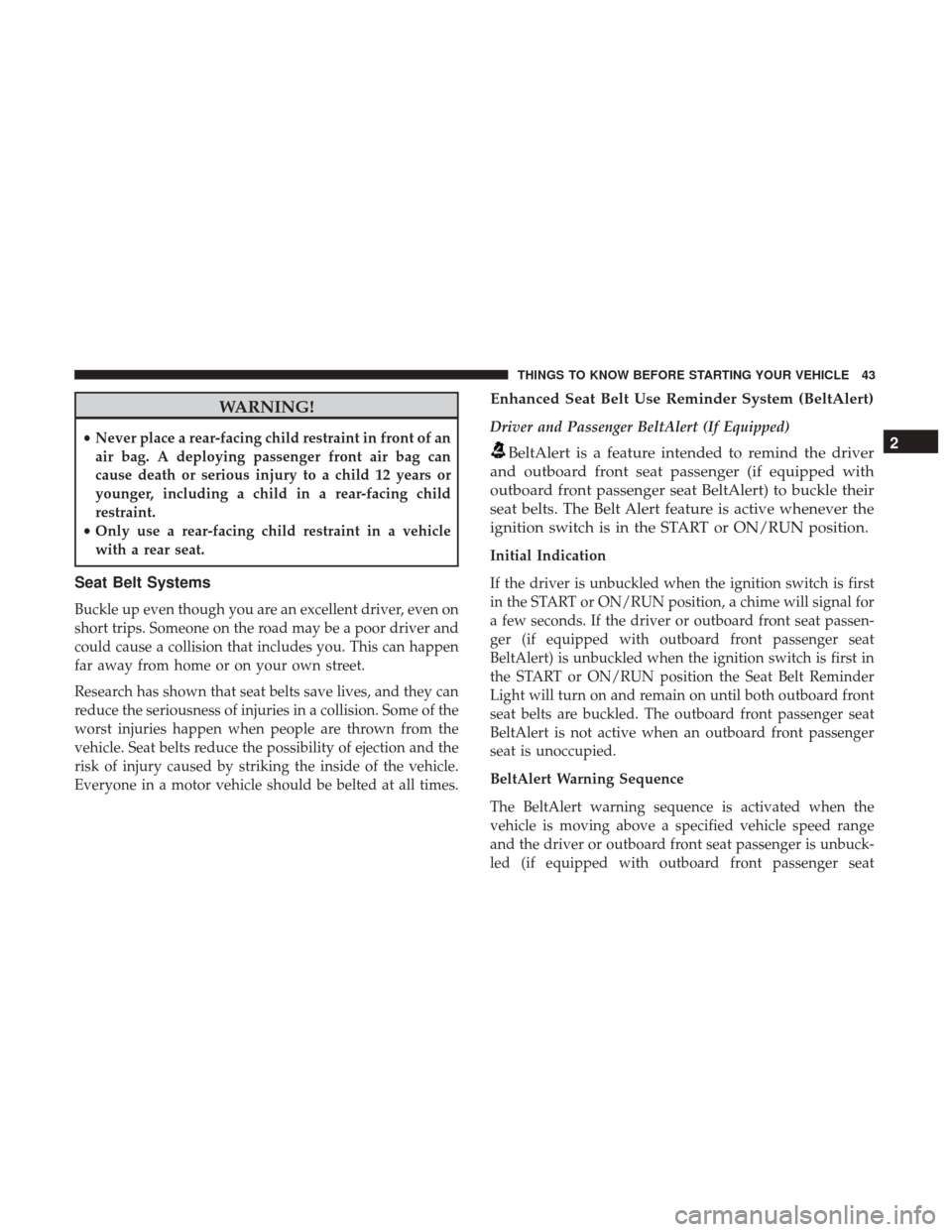
WARNING!
•Never place a rear-facing child restraint in front of an
air bag. A deploying passenger front air bag can
cause death or serious injury to a child 12 years or
younger, including a child in a rear-facing child
restraint.
• Only use a rear-facing child restraint in a vehicle
with a rear seat.
Seat Belt Systems
Buckle up even though you are an excellent driver, even on
short trips. Someone on the road may be a poor driver and
could cause a collision that includes you. This can happen
far away from home or on your own street.
Research has shown that seat belts save lives, and they can
reduce the seriousness of injuries in a collision. Some of the
worst injuries happen when people are thrown from the
vehicle. Seat belts reduce the possibility of ejection and the
risk of injury caused by striking the inside of the vehicle.
Everyone in a motor vehicle should be belted at all times.
Enhanced Seat Belt Use Reminder System (BeltAlert)
Driver and Passenger BeltAlert (If Equipped)
BeltAlert is a feature intended to remind the driver
and outboard front seat passenger (if equipped with
outboard front passenger seat BeltAlert) to buckle their
seat belts. The Belt Alert feature is active whenever the
ignition switch is in the START or ON/RUN position.
Initial Indication
If the driver is unbuckled when the ignition switch is first
in the START or ON/RUN position, a chime will signal for
a few seconds. If the driver or outboard front seat passen-
ger (if equipped with outboard front passenger seat
BeltAlert) is unbuckled when the ignition switch is first in
the START or ON/RUN position the Seat Belt Reminder
Light will turn on and remain on until both outboard front
seat belts are buckled. The outboard front passenger seat
BeltAlert is not active when an outboard front passenger
seat is unoccupied.
BeltAlert Warning Sequence
The BeltAlert warning sequence is activated when the
vehicle is moving above a specified vehicle speed range
and the driver or outboard front seat passenger is unbuck-
led (if equipped with outboard front passenger seat
2
THINGS TO KNOW BEFORE STARTING YOUR VEHICLE 43
Page 46 of 530
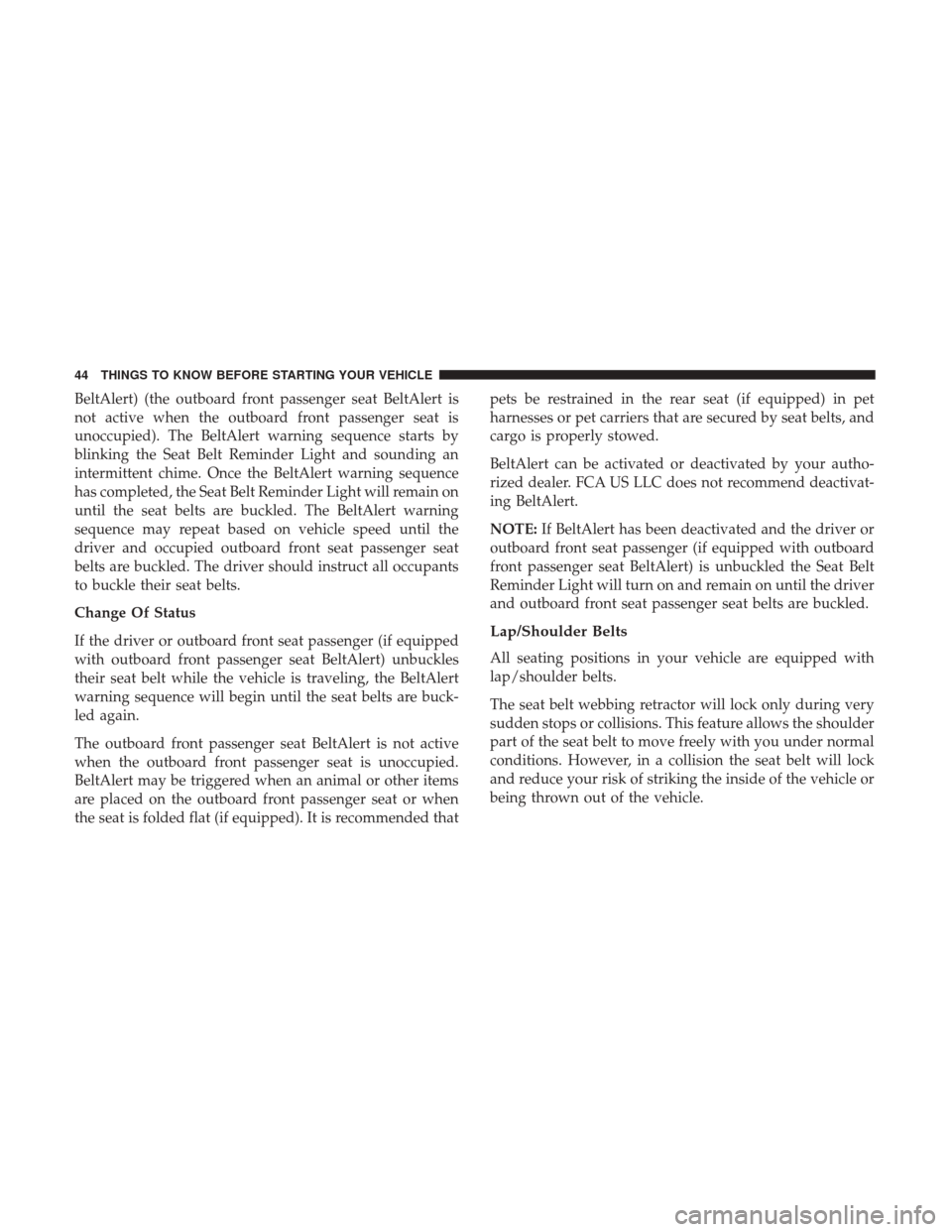
BeltAlert) (the outboard front passenger seat BeltAlert is
not active when the outboard front passenger seat is
unoccupied). The BeltAlert warning sequence starts by
blinking the Seat Belt Reminder Light and sounding an
intermittent chime. Once the BeltAlert warning sequence
has completed, the Seat Belt Reminder Light will remain on
until the seat belts are buckled. The BeltAlert warning
sequence may repeat based on vehicle speed until the
driver and occupied outboard front seat passenger seat
belts are buckled. The driver should instruct all occupants
to buckle their seat belts.
Change Of Status
If the driver or outboard front seat passenger (if equipped
with outboard front passenger seat BeltAlert) unbuckles
their seat belt while the vehicle is traveling, the BeltAlert
warning sequence will begin until the seat belts are buck-
led again.
The outboard front passenger seat BeltAlert is not active
when the outboard front passenger seat is unoccupied.
BeltAlert may be triggered when an animal or other items
are placed on the outboard front passenger seat or when
the seat is folded flat (if equipped). It is recommended thatpets be restrained in the rear seat (if equipped) in pet
harnesses or pet carriers that are secured by seat belts, and
cargo is properly stowed.
BeltAlert can be activated or deactivated by your autho-
rized dealer. FCA US LLC does not recommend deactivat-
ing BeltAlert.
NOTE:
If BeltAlert has been deactivated and the driver or
outboard front seat passenger (if equipped with outboard
front passenger seat BeltAlert) is unbuckled the Seat Belt
Reminder Light will turn on and remain on until the driver
and outboard front seat passenger seat belts are buckled.
Lap/Shoulder Belts
All seating positions in your vehicle are equipped with
lap/shoulder belts.
The seat belt webbing retractor will lock only during very
sudden stops or collisions. This feature allows the shoulder
part of the seat belt to move freely with you under normal
conditions. However, in a collision the seat belt will lock
and reduce your risk of striking the inside of the vehicle or
being thrown out of the vehicle.
44 THINGS TO KNOW BEFORE STARTING YOUR VEHICLE
Page 61 of 530

The air bag system must be ready to protect you in a
collision. The Occupant Restraint Controller (ORC) moni-
tors the internal circuits and interconnecting wiring asso-
ciated with the electrical Air Bag System Components.
Your vehicle may be equipped with the following Air Bag
System Components:
Air Bag System Components
Your vehicle may be equipped with the following air bag
system components:
•Occupant Restraint Controller (ORC)
• Air Bag Warning Light
•Steering Wheel and Column
• Instrument Panel
• Knee Impact Bolsters
• Driver and Front Passenger Air Bags
• Supplemental Side Air Bags
• Supplemental Knee Air Bags
• Front and Side Impact Sensors
• Seat Belt Pretensioners •
Seat Track Position Sensors
• Seat Belt Buckle Switch
Air Bag Warning Light
The ORC monitors the readiness of the electronic
parts of the air bag system whenever the ignition
switch is in the START or ON/RUN position. If
the ignition switch is in the OFF position or in the
ACC position, the air bag system is not on and the air bags
will not inflate.
The ORC contains a backup power supply system that may
deploy the air bag system even if the battery loses power or
it becomes disconnected prior to deployment.
The ORC turns on the Air Bag Warning Light in the
instrument panel for approximately four to eight seconds
for a self-check when the ignition switch is first in the
ON/RUN position. After the self-check, the Air Bag Warn-
ing Light will turn off. If the ORC detects a malfunction in
any part of the system, it turns on the Air Bag Warning
Light, either momentarily or continuously. A single chime
will sound to alert you if the light comes on again after
initial startup.
2
THINGS TO KNOW BEFORE STARTING YOUR VEHICLE 59